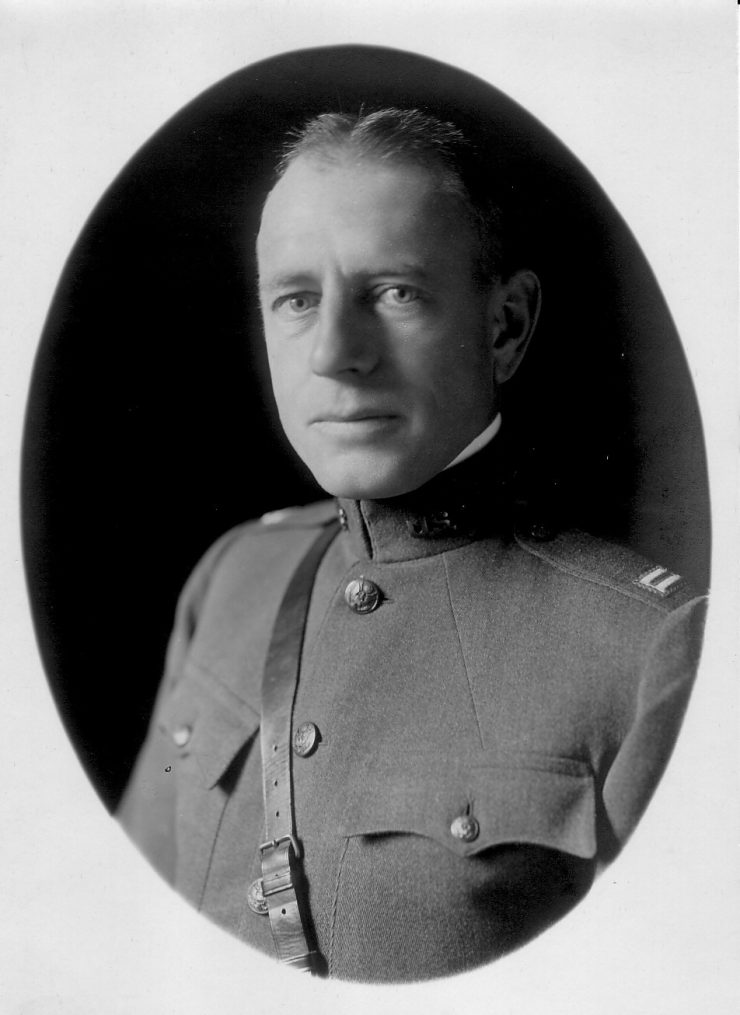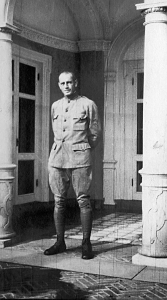Captain George A. Lyon

George Lyon was a captain in World War I. In July 1918, as he waited for orders to Europe, he wrote a touching letter to his wife, Marjorie, “…a farewell note to tell you how much I love you … I hope, and expect, to come back, but of course I may not.” He ended on a positive note: “I am so glad to finally be on the way to do my part. God bless and keep you safe for my homecoming.” To his mother-in-law, Bessie, he wrote, “This is to bid you goodbye … I am so happy to go … Take care of my wife. She needs support and love … I am doing right, and I shall come back please God.”
On September 22, George and his men hiked 22 miles with full equipment (70 lbs.) through the Vosges Mountains to the back of the line, almost on the Alsace border. George wrote proudly of “standing the gaff” better than men half his age (he was already 40 years old).

George Lyon, Blithewold 1917
On November 10 George was at Sommedieue, near the front. “Sunday the 10th a beautiful clear November day we went into action. We were shelled all the way up to where we deployed, but it was nothing to what we then got. My company was without any shelter, and we advanced for six hours under continuous Machine Gun and Artillery fire. The men behaved magnificently, and I was amply repaid for all the work and energy I’ve put into getting a well disciplined company.” He wrote that his troop had suffered over 25% casualties that day, “… and mighty near went over myself. Machine gun fire is not so bad – you don’t realize what the sing of the bullets means, but there is no question about the terror of high explosive shells.” The next day, November 11, 1918, the regiment prepared to go into action again, through a heavy fog. “We went back to the trenches along the road about 2 A.M., and … laid together for warmth until daylight in a shallow ditch. We were just getting ready to move in behind them, when the shelling, and machine gun fire suddenly stopped. There was complete silence for a moment or two. It was eleven o’clock and the armistice was on.” Indeed, it was the eleventh day of the eleventh month: the Armistice had been declared and the war was over.
George’s regiment now had to go back 125 miles to GHQ, and he did not return home for another six months. Even though the war was officially over, George was in Chaumont (southeast of Paris) in January 1919. As a member of the General Staff in the Operations Section, he was charged with reading through official documents, which he found intensely interesting. His new work and living conditions were in stark contrast to his recent life with the troops. Instead of a damp trench he had a big, warm office with clerks, stenographers, and orderlies to do his bidding. In letters to Marjorie he described his accommodations as very luxurious. The large house had a Parisian chef, and George enjoyed the company of visiting former ambassadors, generals, colonels, and a former attorney general. After-dinner conversation around the fire included talk of Pershing and Foch, Pétain and Haig, Wilson and Lloyd George, “and other Great Personages bandied about by men who know them. Can you imagine anything more fascinating?” George had been craving meaningful intellectual exchange and stimulation and found it with many of his new colleagues: “…many of them look on me with a certain envy because I have been on active service with the troops!”
George was invited to be part of a team that would tour the battlefields. He and another man were given a Cadillac and sent out to inspect the places where their company had seen action and to go through the German trenches. He finally arrived back in Boston at the beginning of May 1919, ready to slip back into civilian life. In August 1919 the French government awarded him the prestigious Croix de Guerre for his bravery and endurance during the war. The certificate is preserved in the archives at Blithewold.
